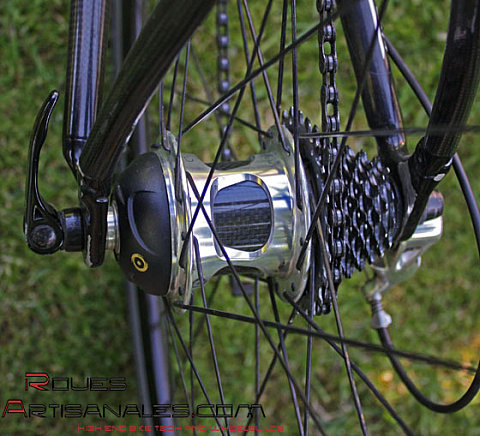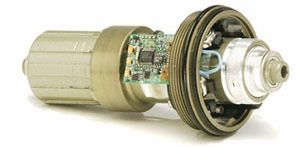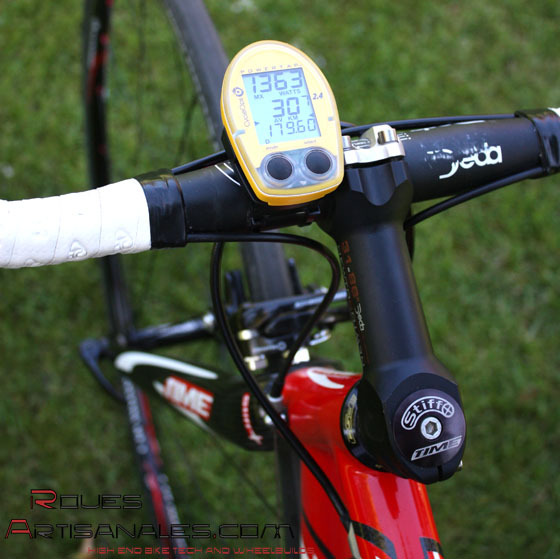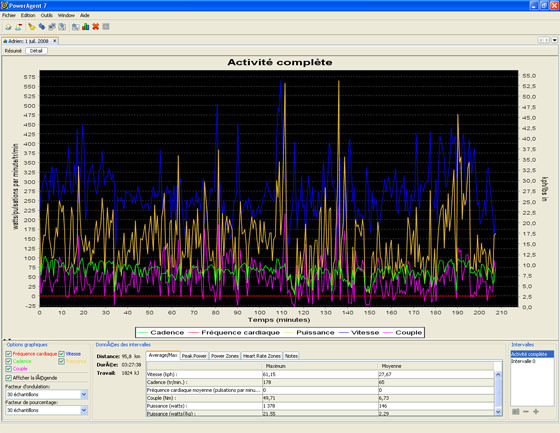|
What’s that?
The Powertap is one of the required tool for a good quality training and a whole follow-up of the performance. This device is a power sensor integrated into a special rear hub which is
equipped with 8 strain gauges and an oversized carbon/aluminium shell. The precision is excellent: the error margin is only 1,5%, and it is really hard to go back to a standard wheel
because the system motivates and encourages the rider to go over its limits…
For the story, we wanted to test this device before offering it in the roues artisanales boutique. The racers and sportive riders, who wish to improve their performances and have a real
representation of the output power should be particularly interested.
Indeed, on the road, the power provided changes every second and several parameters, whose the wind and slope, modify dramatically the output. Thus, while every sundays a rider rides easily
at 30km/h, with the wind in the back, another days he can’t go over 20km/h with the wind in the face. One feels out of shape, stuck on the road. Nevertheless with a power sensor such as the
Powertap, the real output would be known. The first day, with the wind in the back, the output power is between 180 to 220W… the next day with the wind in the face, it is between 300 and
350W!

How does it work?

From a technical
point of view, we touch the top of the world with this product. Internally, height strain gauges measure the deformation in torsion of a calibrated component, involved in the strength
transmission. The strain gauges resistivity variates and influences an oscillator whose oscillating frequency represents a torque in N.m. In short, that’s not a product to disassemble, even
for the most handyman of us…
The rider creates a torque which is associated to a pedaling frequency. The torque (spinning force so it’s in N.m) multiplied by this speed (rad/s) is a power in Watts.
Thus for a given output power, we can either push the pedals like hell, and spin the legs slowly (high torque, low speed), either spin quickly the legs, and delivering a lower force (high
speed and low torque)
The comptuter
The power meter displays instantaneously the power on a special comptuter. Beside the power, speed, pedaling frequency, hearth rate, odometer, we enjoied the torque display during the high
strength trainings.
The comptuter displays datas on three levels:
1 – Output power, maximal power, average power – Force
2 – Speed, max speed, average speed
3 – Distance, time/hour, pedaling frequency, average pedaling frequency, energy spent, odometer, hearth rate, average hearth rate
The settings are a bit more complicated than with a standard comptuter. Indeed, we had to modify the power refresh display from 1s to 2s because the variations were too quick. Although we
were riding at – what we estimated to be a very constant power, the power variated from 140 to 180W! The longer power display refresh smoothen the power variations.

Power Agent, the software
A special software is provided with the device. It helps to analysis into the details the ride/race. The comptuter can record several trainings, as long as the total is not longer than 15
hours. When plugging it to the comptuter, through USB, every rides are separated and you simply have to import the datas. The transfer may take several minutes if you have many hours of
training to analysis.
The software shows the power curve, speed curve, torque curve, pedaling frequency, and finally hearth rate curve, all as a function of the time. However the software is not limited to
showing these curves, it saves all your trainings since the first time, through a list in the chronological order, and can give you extra information such as the output power or hearth rate
distribution, etc…

Some principles…
Here are some power figures depending on the rider level and the effort. The distances the riders can hold those power levels obviously get bigger with higher level athlets. For example, a
professionnal race is more or less 200km while a regional race (france) is about 90km!
Level/
Type of effort
|
Recreationnal rider
|
Regional racer
Regular cyclosportive
|
National/elite racer
Very good cyclosportive
|
Pro rider
|
|
Sprint (some seconds)
|
600W
|
900W
|
1200W
|
2000W (that’s what the rumors says for the strongest riders!)
|
|
Race (average power)
|
200W
|
250W
|
280W
|
320W
|
|
Time-trial (average power)
|
250W
|
280W
|
320W
|
380W
|
|
Endurance (average power)
|
120W
|
150W
|
180W
|
220W
|
Warning: the powers claimed above are mentionned as example. They are not necessary fixed, a recreationnal rider can have a higher sprint power than a cyclosportive rider!
The range
Three range is composed of three models. Basically, they all offer the same things in term of precision and functionnality: the error margin is 1.5%, the hub shell is in carbon/aluminium,
and they provide the same functions.
Yet, there are some differences from a practical and weight point of view. The cheaper version is the Powertap Pro, which is 899 euros and is equipped with a steel freewheel and
axle, it weights 576g and the transmission is assured by wires. The second model is the Powertap SL, featuring an alloy freewheel and axle: it costs 1199 euros and weights 416g.
Finally, the best power sensor is the Powertap SL 2.4, it has the exact same characteristics as the SL model, but it is wireless! It is 1499 euros.
Conclusion
Finally, the apparel gave us complete satisfaction. It is a training device, which can be very useful for racers or cyclosportives looking for higher performances, to improve their maximal
power, their endurance power, as well as improving their rest.
The powermeter was an excellent ride buddy too since it broke the monotony coming along with long rides.
We finally decided to offer it in our roues artisanales boutique.
|




